Articulating booms: Electric launches
09 January 2023
Most of the recent launches of articulating booms are unsurprisingly electric-related as the interest in battery-powered MEWPs continues.
A surprise attendee at the Bauma exhibition last October was JLG, or at least, the company announced its presence in the weeks leading up to the show, having originally decided not to be present.
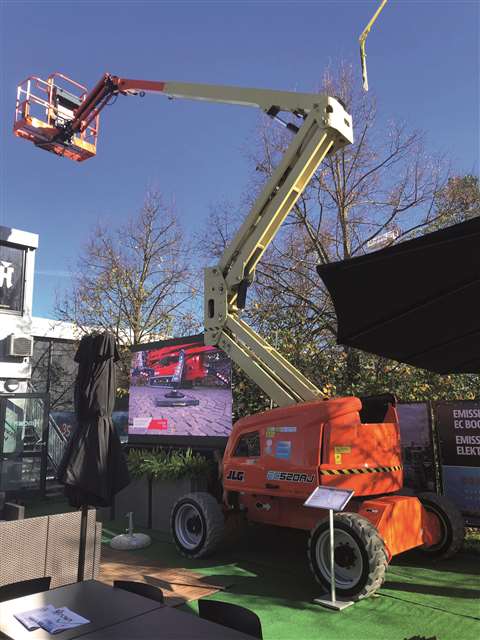 JLG’s updated EC Series Gen 2, at Bauma. (Photo: JLG)
JLG’s updated EC Series Gen 2, at Bauma. (Photo: JLG)
JLG was on display at the Munich show on its partner Hinowa’s stand. (Since then, we have learned that JLG is set to acquire Hinowa).
The company was launching the renewed version of its electric booms, EC Series models.
As mentioned, JLG had previously planned not to attend Bauma. However, its relationship with Hinowa and their manufacturing agreement, created an opportunity for JLG to present its products.
The partnership between the two companies was formed in 2010, when JLG Industries agreed to sell four of Hinowa’s spider lifts exclusively in the US and other markets outside the EU.
Over the years the supply agreement evolved to a broader partnership and extended the JLG’s spider offering to six models and a manufacturing agreement under which the Italy-based company produces JLG’s electric boom lift series, the EC Series.
Updates to the two new 15.72m and 18m working height EC Boom Series Mark II models include an advanced battery technology, with an improved battery capacity of 10kW, with the option to upgrade the pack to 20kW for prolonged duty cycles and autonomy.
JLG also made improvements around cold weather performance and introduced a 4x4 wheel drive option to increase terrain capability, a feature that had been requested by customers.
Karel Huijser, general manager JLG in EMEAI, comments, “The launch of the EC Series Gen 2 marks a successful collaboration between our two companies.”
Low emission booms
Huijser adds, “Whilst not being present at Bauma, we are proud to unveil the EC Series at the Hinowa stand.”
Manitou Group is accelerating the roll out of its Oxygen low emissions range with two further rough terrain models.
The rough terrain 160 ATJe and 180 ATJe, with working heights of 16m and 18m respectively, joins the 200 ATJe model launched at the previous Bauma in 2019.
As of this year, the 20m 200 ATJe is available with four-wheel steer for greater manoeuvrability and a basket that can now take 250kg of capacity - 30kg more than on the two-wheel drive version.
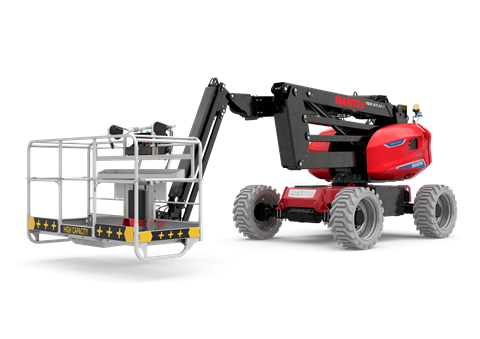 Manitou’s new 160 ATJe. (Photo: Manitou)
Manitou’s new 160 ATJe. (Photo: Manitou)
The 160 ATJe and 180 ATJe platforms also see their capacity increased by 50kg to a basket capacity of 250kg. A second version of the 160, named 160 ATJ+ e, offers a significantly larger capacity of 400kg.
A range extender is available for these products in the form of a removable diesel-powered generator common to all the machines.
The 160, 180 and 200 ATJe models also now come with a Safety Pack, which includes an alert if the harness is not attached and detects obstacles around the machine.
A loading pack provides lights positioned on the platform to ensure operators can see and that the platform can be seen.
A new version of the 120 AETJ platform has also been added to the industrial range.
Presented as a sneak preview at Bauma this year, the model has been entirely redesigned and is fitted with asynchronous AC motors.
A lot of work has been done on the accessibility of the components, explains Manitou, such as the pivoting battery containers and tool-free access, for savings on machine maintenance.
This new generation of industrial articulated platforms is equipped with the same diagnosis system as the rough-terrain range for rapid maintenance without the need for external tools.
All these models are currently powered by lead acid batteries, as the company explains, they remain less costly and customers know where they stand with them following years of previous use.
However, there is view to introduce lithium alternatives in the future.
Is electric the future of articulating booms?
Indeed, while diesel boom lifts still outsell electric options by a wide margin, the talk remains around the potential and need for electric equipment going forward.
Therefore, the prominent launches tend to be in this area. As part of that development, OEMs are partnering with specialist firms to develop these products.
The latest one is Genie through its owner Terex Corp, which has invested in US technology company Acculon Energy to accelerate the electrification of its machines.
Acculon, based in Columbus, Ohio, has experience in advanced battery technologies as well as artificial intelligence and cloud-connected products. Terex says it had important expertise in certifying battery-enabled systems.
Simon Meester, Genie president, says, “Now, as the global construction industry gears up to get to the next level of emissions reduction, Genie is excited to be teaming with Acculon.”
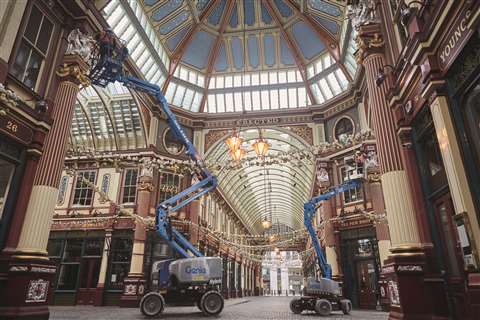 Genie’s Z45-FE is a hybrid machine, and an example of how the company is adapting. (Photo: Genie)
Genie’s Z45-FE is a hybrid machine, and an example of how the company is adapting. (Photo: Genie)
Genie adds that the partnership with Acculon will push the progress on current and future development projects.
Acculon’s president, Andrew Thomas, confirms, “Our partnership will accelerate the delivery of next-generation electrification solutions for Genie equipment and the people who count on that equipment every day.”
As Snorkel points out, once universal charging becomes more widely available, electric power trains are simpler and more cost-effective to maintain on the job than those powered by internal combustion.
For example, the company says its A46JRTE fully electric articulating boom lift reduces battery and electrical-system maintenance enough to drop servicing costs up to 93%, compared to a standard engine.
A big chunk of that reduction is labour, and removing the boom’s engine and hydraulics eliminates the costs and risks of waste oil and filter disposal.
The future of MEWP battery technology
Snorkel adds that today’s sealed, mostly lithium-based batteries also circumvent the significant investment in labour to maintain the water levels in the battery cells.
Also, the performance limits inherent in electric lifts that have drawn power from flooded lead-acid batteries (FLA) since early electrification. And, the chemistry of today’s lithium-based batteries offers inherent performance advantages.
“With a high energy density, lithium-ion batteries are able to discharge more stored energy than lead-acid batteries, making them more efficient,” says Matthew Elvin, CEO of Snorkel.
“Lithium-ion batteries have a better depth of discharge and can be used at a higher capacity before recharging.
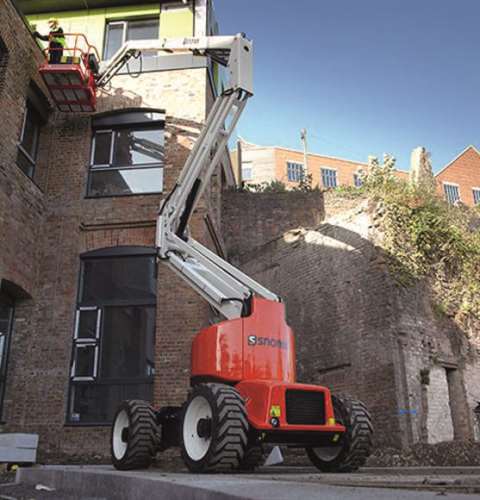 Photo: Snorkel
Photo: Snorkel
“Since lithium-ion batteries have a higher efficiency, they can handle a higher amp to charge faster than lead-acid batteries.
“The closer to full capacity, the slower lead-acid batteries need to be charged to avoid overheating. Additionally, not fully recharging lead-acid batteries could reduce their overall lifespan.”
Dingli, in its recent launch of lightweight equipment has also gone down the electrification and lithium route, as it has done as an option across its whole range of boom lifts.
The D Series, which features seven models, are all available in either electric, diesel or hybrid versions.
Based on its original 16m to 22m boom lifts, the new D series of booms comprises four articulating models, the BA16, BA18, BA20 and BA22, and the BT16, BT18, and BT20 telescopic machines.
The platforms offer working heights from 16m up to 22m and maximum load capacity of 250kg.
The modular design of the machines means that 90% of their main components and over 95% of the structural parts are common to the D Series, making maintenance cheaper and user training simpler.
While the models provide the same height coverage as the manufacturer’s previous series models, their new lightweight design also offers a lower centre of gravity for greater stability.
All seven models, which are suitable for container transport, are equipped with an integrated four-wheel drive system, and their components are located on the sides of the chassis for easy access during maintenance.
The built-in universal range extender enables the machine to generate electricity by itself when there is no external charging facilities on site. Combined with a tank of fuel, the range extender can charge the lithium batteries at anytime.
Like many OEMs, Dingli has taken the lithium battery route, and understands that a lack of charging infrastructure in areas such as Europe, means that diesel powered range extenders that essentially re-charge the lithium battery are a useful tool.
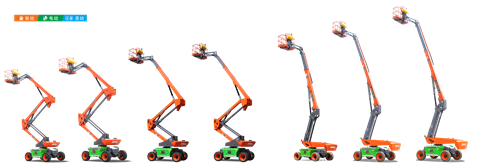 The Dingli D-Series is available in electric, hybrid or diesel versions. (Photo: Dingli)
The Dingli D-Series is available in electric, hybrid or diesel versions. (Photo: Dingli)
It is for this reason that Dingli has introduced a new hybrid boom lift series designed for work on sites where there is no power supply to charge pure electric equipment.
The new Range Extended Series is an advanced version of Dingli’s lithium battery-powered boom lift offering which comes with a ‘mobile charger’, in the form of a small combustion engine.
The series is based on the same specifications as the company’s existing electric boom range, with maximum working heights of 22m to 34m, maximum load of 454kg and a 80V (420Ah) lithium battery pack.
Battery-powered MEWPs
Such is the obvious long-term benefit of electric products, a couple of manufacturers at the recent Bauma exhibition in Germany, chose to only show electric products on their stands.
One of them, Italy-based Airo had chosen two articulated products, the 12m working height A12 JE and the 17m A17 JE.
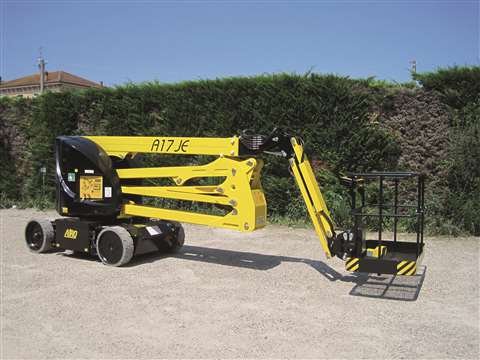 Airo was only showing electric equipment on its Bauma stand, including the A17 JE. (Photo: Airo)
Airo was only showing electric equipment on its Bauma stand, including the A17 JE. (Photo: Airo)
Both have electric drive and AC pump control and offer a range of benefits, including proportional and simultaneous controls and a steel platform with a load limiter.
There is also a 70 degree fold-down jib for reduced transport dimensions and a 230 volt electric line on the platform
That’s on top of the Sentinel Secondary guarding device, with LED flashing lights and acoustic alarm, alongside the Smart pot-hole system for driving at maximum height, diagnostic display and telematics connector.
Another standout feature is the possibility of driving and rotating the turret at the same time, while simultaneous controls allow greater versatility.
Their height, at less than 2m, allows the units to pass through standard doors.
Sinoboom has gone a step further and is only selling electric equipment, including booms, in Europe.
No diesel-powered equipment will be available, along with a range of new articulating lifts including a Plus series model with 450kg lifting capacity that was at Bauma.
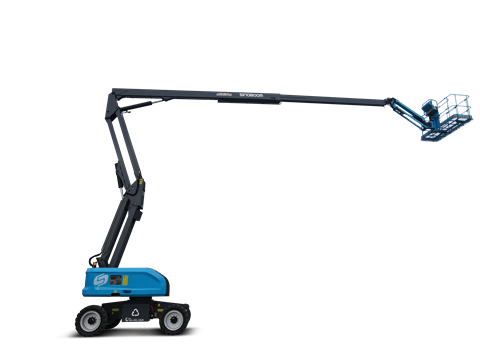 The 23.6m working height AB22EJ Plus from Sinoboom. (Photo: Sinoboom)
The 23.6m working height AB22EJ Plus from Sinoboom. (Photo: Sinoboom)
The 23.6m working height AB22EJ Plus has several platform capacity possibilities, depending on the working envelope.
Unrestricted, the capacity stands at 230kg, reaching to 340kg and 450kg restricted. To complement this, outreach extends to 13.4m, 11.9m or 10.45m, depending on the capacity.
The four-wheel drive offers 40% gradeability and there is standard active axle oscillation.
Additional to this is Sinoboom’s Smart display screen for easily available machine status and fault diagnosis.
There is also an auxiliary power system and the company points out that the unit has a Rexroth controller.
The main boom and secondary boom are equipped with angle sensors, to reduce speed and act as a buffer. Proportional steering speed reduction technology is also available.
All these again will be complemented by Sinoboom’s new factory in Poland. The proximity of the new facility in Poznań, western Poland, to Sinoboom’s European subsidiary in the Netherlands, represents a significant milestone in Sinoboom’s global strategy for a localised focus.
The facility occupies an area of 20,000m2, and features product lines including electric slab and rough terrain scissor lifts, articulating and telescopic boom lifts and an annual production capacity of 20,000 units.
Electric Lightweight
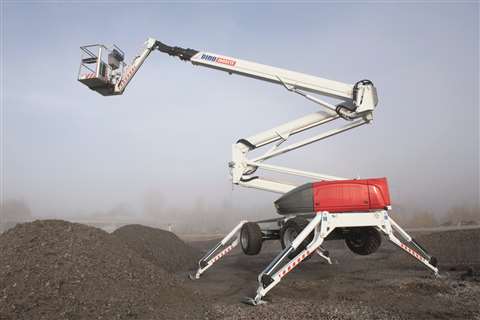 The Dinolift RXTE is an extension of the Dino RXT Series. (Photo: Dino)
The Dinolift RXTE is an extension of the Dino RXT Series. (Photo: Dino)
Lightweight equipment is the name of the game at Dinolift and now the company has extended this to its first all-electric boom lift, which was launched in August and shown at Bauma.
The Dino RXTE, with outriggers, is an extension of the Dino RXT Series of lightweight 4x4 boom lifts, with the advantage of silent operation and zero emissions and lower cost of operation.
As with the existing diesel versions, the series includes two models with working heights of 22m and 28m, equipped with either an AGM or Li-Ion battery pack.
One of the design principles of the new models was that there would be no loss on drive or boom operation speeds, compared to the diesel machines.
The RXTE has a range of lift functions that can be used at the same time, such as operating the outriggers simultaneously while driving is also possible. The electric motor has a continuous power rating of 15kW while the peak power is 20kW.
Thanks to the lightweight structure and outriggers, there is a general reduction in operational costs when comparing the RXT or RXTE to a larger boom lift with a larger 19kW engine. The units can be used in areas with load restrictions or where the surface is soft, for example lawns.
Another feature of the RXTE is that the structure and hydraulics largely coincide with the diesel model.
For tough work environments, where battery power may be depleted sooner, there is an optional combustion engine range extender that can be bolted onto the unit to charge the battery if required in non-environmentally sensitive settings.




